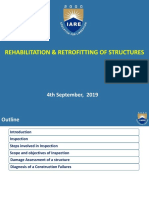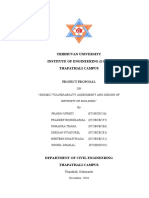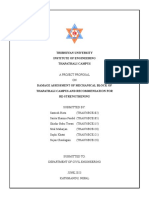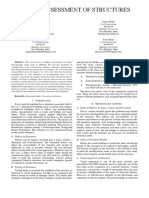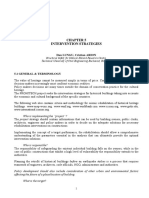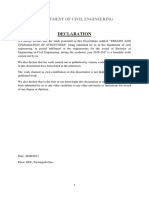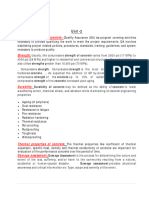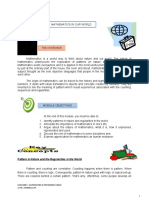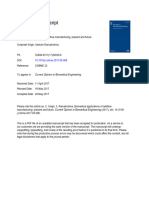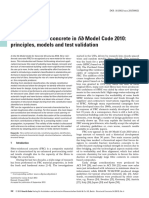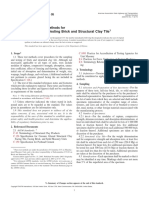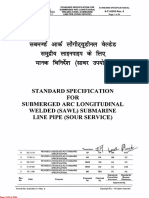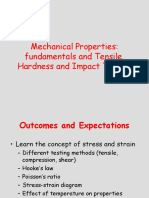Module - 02
Uploaded by
Suman SahModule - 02
Uploaded by
Suman SahCOURSE NAME: REHABILITATION AND RETROFITTING FACULTY: K S JAYADEEP
COURSE CODE: 18CV824 AY: 2023 - 2024
-------------------------------------------------------------------------------------------------------------------------------------------------------------------------------------------------------------------------------
MODULE: 02
DEPARTMENT OF CIVIL ENGINEERING, RRIT P a g e | 32
COURSE NAME: REHABILITATION AND RETROFITTING FACULTY: K S JAYADEEP
COURSE CODE: 18CV824 AY: 2023 - 2024
-------------------------------------------------------------------------------------------------------------------------------------------------------------------------------------------------------------------------------
DAMAGE ASSESSMENT:
Assessment: Assessment in civil engineering involves evaluating the condition or performance
of a structure or system to determine its safety, reliability, and functionality.
Damage Assessment (Condition Assessment):
It is the process of evaluating the extent and nature of damage to a structure or system
caused by natural disasters, accidents, or other events.
It is one of the qualitative evaluation techniques to assess the condition or state of the
buildings.
Objectives:
a) To determine the severity of the damage, identify and to understand the extent of damage.
Photos have to be taken in visual observation about damages has to be documented
systematically
The visible distress harmful or causing damage to safety of structures such as cracks
in beams, columns, and slabs, spalling of concrete, sagging of beams or slabs and
major failure of structural members have to be recorded.
Identifying the causes of distress and listing the factors such as deficiency in design,
poor detailing of structural members, poor quality of construction, extreme and
unforeseen loading, inadequacy of the structural system resist natural hazards.
b) Assess the type and extent of damage and carry out damage assessment of structures
through various types of tests.
Conducting tests such as NDT,SDT & DT the extent of distress and deterioration can
be evaluated.
Based on the results from the tests the residual strengths of structural elements can be
determined
c) To develop a repair or remediation strategy to restore the functionality and safety of the
structure or system.
Structural and non-structural repairs required for crucial and critical damages to restore
the structure has to be done.
The methods of repair and retrofitting shall be decided to strengthen the building.
DEPARTMENT OF CIVIL ENGINEERING, RRIT P a g e | 33
COURSE NAME: REHABILITATION AND RETROFITTING FACULTY: K S JAYADEEP
COURSE CODE: 18CV824 AY: 2023 - 2024
-------------------------------------------------------------------------------------------------------------------------------------------------------------------------------------------------------------------------------
Rapid Assessment:
It is also known as preliminary investigation or visual investigation.
It mainly includes
a) Collection of information and details about building design, construction, past utilization,
and past maintenance.
Building design details and drawings.
Architectural details.
Construction details and drawings including the specifications of materials used,
Geotechnical details of the area and foundation particulars,
Details of any repair or retrofitting done from the time of construction.
Details of usage of the building including the loads
b) Visual inspection of condition at site and recording details of distress.
The main objective of visual investigation is to observe and note down all the items of
distress or design deficiency and their locations, supported with sketches and drawings.
Verification of the accuracy of the original drawings. If no drawings are available,
determination of basic building information.
Identification of major alterations not shown in original construction documents.
Identification of visible structural damage, such as concrete cracking or spalling, and
observations on quality of construction.
Identification of potential non-structural falling hazards, including ceilings, partitions,
curtain walls, parapets, fixtures, and other non-structural building elements.
Observation of condition of soil and the foundations.
DEPARTMENT OF CIVIL ENGINEERING, RRIT P a g e | 34
COURSE NAME: REHABILITATION AND RETROFITTING FACULTY: K S JAYADEEP
COURSE CODE: 18CV824 AY: 2023 - 2024
-------------------------------------------------------------------------------------------------------------------------------------------------------------------------------------------------------------------------------
c) Evaluation of safety of buildings against the provisions in buildings codes or specified
performance criteria.
Evaluation of performance of structure to its intended used.
Evaluation of structural health and safety as per necessary and required Codal provisions.
Verification of structural details, design procedures and other required considerations as
per codes.
Detailed Assessment:
The detailed investigations have to be conducted about the total structural systems and about
the details of type, location and severity of damage or distress in various members and the
system.
Dimension of structural elements have to be measured.
Properties of structural elements i.e., concrete, steel reinforcement are determined by
conducting various tests.
Basic geotechnical investigations needs to be conducted to get details about soil profile and
its characteristics.
Identification of weak zones in a structure, a detailed assessment of the in-situ quality of the
material.
Results from NDT, SDT & DT should be analysed and suitable measures should be taken.
Investigation of damage (DAMAGE ASSESSMENT) and its procedure:
Physical inspection of damaged structure.
Preparation and documenting the damages.
Collection of samples and carrying out tests both in situ and lab.
Studying the documents including the structural aspects.
Estimation of loads acting on structure.
Estimation of environmental effects including Soil-structure interaction.
Diagnosis.
Taking preventive steps not to cause further damage.
Retrospective analysis to get the diagnosis confirmed.
Assessment of structural adequacy.
Remedial measures necessary to strengthen and repairing the structure.
Post-repair evaluation through tests.
Load test to study the behaviour.
Choice of course of action for the restoration of the structure.
DEPARTMENT OF CIVIL ENGINEERING, RRIT P a g e | 35
COURSE NAME: REHABILITATION AND RETROFITTING FACULTY: K S JAYADEEP
COURSE CODE: 18CV824 AY: 2023 - 2024
-------------------------------------------------------------------------------------------------------------------------------------------------------------------------------------------------------------------------------
Damage Assessment flowchart
DEPARTMENT OF CIVIL ENGINEERING, RRIT P a g e | 36
COURSE NAME: REHABILITATION AND RETROFITTING FACULTY: K S JAYADEEP
COURSE CODE: 18CV824 AY: 2023 - 2024
-------------------------------------------------------------------------------------------------------------------------------------------------------------------------------------------------------------------------------
EVALUATION OF CRACKS:
The cracks in a structure are broadly classified into two categories:
a) Superficial cracks or surface cracks
b) Structural cracks
Surface cracks refer to cracks or fissures that occur on the outermost layer or surface of a
material. These cracks are typically visible to the naked eye and can vary in size, shape, and
depth. These cracks are usually shallow and do not penetrate deep into the material. Superficial
cracks does not affect the structural integrity or functionality of the material
Structural cracks are cracks that occur in load-bearing elements or components of a structure,
such as walls, columns, beams, slabs, or foundations. These cracks can be more severe and have
implications for the structural integrity and stability of the building or structure. Structural cracks
are typically larger, deeper, and may exhibit signs of displacement, such as opening or shifting.
The structural cracks may be active or dormant. A crack where movement is observed is called
active and cracks without movement is called dormant.
The following information may help in diagnosing the cracks
Age of cracks whether the crack is new or old.
Type of crack whether the crack is active or dormant.
Evaluating whether the crack is appearing in opposite face of the member.
Identification of pattern of crack.
Weather conditions during construction of structures.
Study of information, method of construction and test results.
Before proceeding with repair, the investigations should be made to determine the location and
extent of cracking, the causes of damage, and the objectives of repair.
The evaluation of cracks is necessary for the following purposes:
To identify the cause of cracking.
To assess the structure for its safety and serviceability.
To establish the extent of the cracking.
To establish the likely extent of further deterioration.
To study the suitability of various remedial measures,
To make a final assessment for serviceability after repairs
Apart from visual inspection, tapping the surface and listening to the sound for hollow areas
may be one of the simplest methods of identifying the weak spots. The suspected areas are
then opened up by chipping the weak concrete for further assessment.
DEPARTMENT OF CIVIL ENGINEERING, RRIT P a g e | 37
COURSE NAME: REHABILITATION AND RETROFITTING FACULTY: K S JAYADEEP
COURSE CODE: 18CV824 AY: 2023 - 2024
-------------------------------------------------------------------------------------------------------------------------------------------------------------------------------------------------------------------------------
TESTS CONDUCTED FOR DAMAGE ASSESSMENT
Non-destructive testing systems(NDTS): NDT is a testing and analysis technique used by
industry to evaluate the properties of a material, component, structure or system for characteristic
differences, defects, and discontinuities without causing damage to the original part.
NDT evaluation is widely employed for inspecting the condition of structures, and are less time
consuming and relatively inexpensive, can be used for the following purposes:
Test on actual structures.
Test at several locations.
Test at various stages.
Assess the quality control of actual structures.
Assess the uniformity of the concrete.
Assess the materials used and workmanship with specification.
Assess the poor construction practices.
Assessment of the extent of cracks, voids, honeycombs.
Confirmation of suspected distress due to poor design
Assessment of partial durability
Integrity testing of piles
Monitoring of progressive changes in structure
The different Non-destructive tests are as follows:
Surface hardness Method
Ultrasonic pulse velocity method
Resonant frequency method
Dynamic or vibration method
Pulse attenuation method
Pulse Echo method
Radioactive method
Nuclear methods
Magnetic methods
Electromagnetic methods
Electrical methods
Acoustic emission techniques
Radar technique
Radiography methods
DEPARTMENT OF CIVIL ENGINEERING, RRIT P a g e | 38
COURSE NAME: REHABILITATION AND RETROFITTING FACULTY: K S JAYADEEP
COURSE CODE: 18CV824 AY: 2023 - 2024
-------------------------------------------------------------------------------------------------------------------------------------------------------------------------------------------------------------------------------
Semi-destructive testing systems (SDTS): Semi destructive test are used for assessing the in-
situ concrete strength. These tests cause localized damage, which do not cause any loss in the
performance of the structure.
The Semi-destructive tests are conducted to determine the following
i. Determination of cement content.
ii. Determination of water content.
iii. Determination of water-cement ratio.
iv. Determination of pH value of concrete.
The different Semi-destructive tests are as follows:
Penetration techniques
Pull out and Pull-off tests
Core sampling and testing
Break off tests
Permeability tests
Resistivity survey
Carbonation and pH value test
Chloride content test
Half-cell potential survey
Abrasion resistance test
Destructive testing systems(DTS): Destructive testing is undertaken in order to understand a
specimen’s performance or material behaviour, these procedures are carried out to the test
specimen’s failure. Destructive testing procedures can either follow specific standards or can be
tailored to reproduce set service conditions.
The destructive test includes:
Direct load test
DEPARTMENT OF CIVIL ENGINEERING, RRIT P a g e | 39
COURSE NAME: REHABILITATION AND RETROFITTING FACULTY: K S JAYADEEP
COURSE CODE: 18CV824 AY: 2023 - 2024
-------------------------------------------------------------------------------------------------------------------------------------------------------------------------------------------------------------------------------
NON-DESTRUCTIVE TESTING SYSTEMS(NDTS):
a) Surface hardness Method: Rebound Hammer test is a Non-destructive testing method of
concrete which provide a convenient and rapid indication of the compressive strength of the
concrete.
Principle: Rebound hammer test method is based on the principle that the rebound of an
elastic mass depends on the hardness of the concrete surface against which the mass strikes.
The most commonly and widely used instrument is a rebound hammer.
The rebound hammer is also called as Schmidt hammer that consist of a spring-controlled
mass that slides on a plunger within a tubular housing.
The method consists of impacting the surface in a standard manner
Activating the mass by a given energy and measuring rebound or indentation.
There are several types of hammer with varying energy
Lower impact energy is 0.07 to 0.09 kg-m. and higher impact energy from 0.07 to 3kg-m.
Lower impact energy is used to determine the strength of material.
Higher impact energy is used for mass concrete, pavements, and airport runways.
DEPARTMENT OF CIVIL ENGINEERING, RRIT P a g e | 40
COURSE NAME: REHABILITATION AND RETROFITTING FACULTY: K S JAYADEEP
COURSE CODE: 18CV824 AY: 2023 - 2024
-------------------------------------------------------------------------------------------------------------------------------------------------------------------------------------------------------------------------------
Test procedure:
The test procedure consists of applying the hammer on the concrete surface and observing
the rebound reading indicated by a rider over a scale.
Before applying the hammer, the surface of the concrete is cleaned and smoothened.
When the plunger of rebound hammer is pressed against the surface of concrete, a spring-
controlled mass with a constant energy is made to hit concrete surface to rebound back.
The extent of rebound, which is a measure of surface hardness, is measured on a graduated
scale. This measured value is designated as Rebound Number (rebound index).
A minimum of 10 readings are compared and each reading should not differ by more than 7
units.
The average of remaining readings is determined for evaluating the strength.
The procedure for determining the rebound values has been specified in BIS-13311 Part 2
Thus, the hardness of concrete and rebound hammer reading can be correlated with
compressive strength of concrete.
The rebound value is read off along a graduated scale and is designated as the rebound
number or rebound index.
The hammer is held at right angles to the surface on the concrete i.e., in vertically upward,
vertically downward and in horizontal position.
Rebound Hammer Quality of concrete
Greater than 40 Very good hard layer
30 to 40 Good Layer
20 to 30 Fair
Lesser than 20 Poor Concrete
20 Delaminated
DEPARTMENT OF CIVIL ENGINEERING, RRIT P a g e | 41
COURSE NAME: REHABILITATION AND RETROFITTING FACULTY: K S JAYADEEP
COURSE CODE: 18CV824 AY: 2023 - 2024
-------------------------------------------------------------------------------------------------------------------------------------------------------------------------------------------------------------------------------
b) Ultrasonic pulse velocity method:
The objective of this method is basically to measure the velocity of the pulses of longitudinal
vibrations passing through concrete.
Three types of waves are generated by an impulse applied to a solid mass.
Longitudinal, shear and Rayleigh waves
Longitudinal waves are fastest and provide more useful information.
The velocity of an ultrasonic pulse is influenced by properties of concrete which determines
elastic stiffness and mechanical strength.
The variation in the pulse velocity values reflect a corresponding variation in the state of
concrete under test.
The test consists of transmitting longitudinal vibrations produced by an electro- acoustical
transducer from one side of the concrete, receiving the signal from the other side and
measuring the transit time (T) of the pulse using electronic time circuits. The path length (L)
of the pulse is measured and velocity (V) is calculated as V-L/T.
The measuring equipment consists of an electrical pulse generator, a pair of transducers, an
amplifier, and an electronic timing device for measuring the time interval elapsing between
the onset of a pulse generated at the transmitting transducer and the onset of its arrival at the
receiving transducer.
Transducers of 50 to 60 kHz are found to be useful for most of the applications in concrete
testing.
There are three possible ways of measuring pulse velocity by direct, Semi-direct and indirect
method.
DEPARTMENT OF CIVIL ENGINEERING, RRIT P a g e | 42
COURSE NAME: REHABILITATION AND RETROFITTING FACULTY: K S JAYADEEP
COURSE CODE: 18CV824 AY: 2023 - 2024
-------------------------------------------------------------------------------------------------------------------------------------------------------------------------------------------------------------------------------
In direct transmission the transmitter and receiver are on the opposites faces of the specimen.
In semi-direct transmission the transmitter and receiver are on the adjacent faces of the
specimen.
In In-direct transmission the transmitter and receiver are on the same faces of the specimen.
The maximum pulses can be obtained in direct transmission and 2% to 3% pulses are
measured in semidirect and indirect transmission.
The quality of concrete is determined based on velocity pulse measured.
UPV V = (km/sec) Concrete quality
V Greater than 4 Very Good
V between 3.5 & 4 Good
V between 3 & 3.5 Poor
V between 2.5 & 3 Very Poor
V between 2 & 2.5 Very Poor & Low integrity
V lesser than 2 Large voids suspected
DEPARTMENT OF CIVIL ENGINEERING, RRIT P a g e | 43
COURSE NAME: REHABILITATION AND RETROFITTING FACULTY: K S JAYADEEP
COURSE CODE: 18CV824 AY: 2023 - 2024
-------------------------------------------------------------------------------------------------------------------------------------------------------------------------------------------------------------------------------
c) Resonant frequency method:
https://www.youtube.com/watch?v=RhcmC0LcAz0
This method is based up on the determination of the fundamental resonant frequency of
vibration of a specimen.
The equipment used is called SONOMETER.
It is mostly a laboratory method
The specimens used are cylinder of size 150mm x 300mm or 75mm x 75mm x 300mm
prisms.
The test is conducted to calculate the dynamic young’s modulus of elasticity of concrete.
The apparatus consists of a slider table on which the specimen is mounted and frequency
measuring device through which resonant frequency is recorded.
The principal used in the Resonant Frequency Tester is based upon the determination of
the fundamental resonant frequency of vibration of a specimen by a driving oscillator and
measuring the resonant frequency of the specimen.
The dynamic young’s modulus of concrete is measured using the relation between
Resonant frequency and young’s modulus of concrete.
Ed = Dynamic young’s modulus
K = Constant = 4 * 10-15 Gpa
N = Resonant frequency
L = Length of specimen
𝜌 = Density of concrete
DEPARTMENT OF CIVIL ENGINEERING, RRIT P a g e | 44
COURSE NAME: REHABILITATION AND RETROFITTING FACULTY: K S JAYADEEP
COURSE CODE: 18CV824 AY: 2023 - 2024
-------------------------------------------------------------------------------------------------------------------------------------------------------------------------------------------------------------------------------
The deterioration due to chemical causes such as acidic and alkali reactions.
To determine the degree of damage due to fire
The deterioration effects of concrete subjected for repeated cycles of freezing and thawing
can be studied.
DEPARTMENT OF CIVIL ENGINEERING, RRIT P a g e | 45
COURSE NAME: REHABILITATION AND RETROFITTING FACULTY: K S JAYADEEP
COURSE CODE: 18CV824 AY: 2023 - 2024
-------------------------------------------------------------------------------------------------------------------------------------------------------------------------------------------------------------------------------
d) Dynamic or vibration method:
This non-destructive method is used to determine young’s modulus of concrete.
The fundamental principle of this method is in the propagation of sound velocity through
a solid material.
The setup consists of concrete specimen fixed on the test apparatus and determination
of the fundamental resonant frequency of vibration of a specimen by a driving oscillator
and measuring the resonant frequency of the specimen.
The resonant frequency is recorded using data acquisition device.
A relationship is developed between sound velocity and resonant frequency through
which the modulus of elasticity of concrete is determined.
V = Sound velocity
g = acceleration due to gravity
E = Young’s modulus of concrete
f = Resonant frequency
𝜌 = Density of concrete
DEPARTMENT OF CIVIL ENGINEERING, RRIT P a g e | 46
COURSE NAME: REHABILITATION AND RETROFITTING FACULTY: K S JAYADEEP
COURSE CODE: 18CV824 AY: 2023 - 2024
-------------------------------------------------------------------------------------------------------------------------------------------------------------------------------------------------------------------------------
e) Pulse attenuation method:
This is a wave propagation method in which electromagnetic waves of frequency ranged
500 MHz to 1000MHz are allowed to propagate through solids.
The basic principle is that the attenuation properties of the electromagnetic waves are
influenced by the electrical properties of the solid material tested.
The apparatus consists of a transmitter to induce electromagnetic waves, receiver to
receive signals and a system to determine the attenuation properties of the waves.
Reflection and refraction of waves occur at interfaces between different materials and the
signal returning to the surface antenna can be interpreted to provide an evaluation of
properties and geometry of subsurface features.
The following are the applications of pulse attenuation method
i. Assess element thickness
ii. Locate reinforcing bars
iii. Locate moisture
iv. Locate voids,
v. Honey combing/cracking
vi. Locate chlorides
vii. Size of voids
viii. Estimate chloride concentration
ix. Locate rebar.
f) Nuclear method:
Use of nuclear methods for non-destructive measurement of some properties of concrete
such as water content and cement content in concrete is a recent advancement.
Two techniques have been reported, namely Neutron Scattering Method and Neutron
activation analysis for determining moisture and cement content in concrete respectively.
The estimation of water and cement content is essential in assessing and preventing
deterioration of concrete due to chemical causes.
These methods are not suitable for finding out the strength of concrete.
DEPARTMENT OF CIVIL ENGINEERING, RRIT P a g e | 47
COURSE NAME: REHABILITATION AND RETROFITTING FACULTY: K S JAYADEEP
COURSE CODE: 18CV824 AY: 2023 - 2024
-------------------------------------------------------------------------------------------------------------------------------------------------------------------------------------------------------------------------------
g) Pulse Echo method:
Pulse echo method has been developed through extensive research and used for practical
application.
The instrument used is named as DOCTOR developed in Denmark and the apparatus
consists of computer, related software, and transducers.
This method was developed to test integrity of piles.
In this method the reflection of pulse is measured using a transducer.
The number of reflected pulses indicate the number of cracks developed inside the
structure.
The method is applicable for
i. Testing for thickness & flaws in concrete
ii. Testing for depths of surface and opening cracks.
DEPARTMENT OF CIVIL ENGINEERING, RRIT P a g e | 48
COURSE NAME: REHABILITATION AND RETROFITTING FACULTY: K S JAYADEEP
COURSE CODE: 18CV824 AY: 2023 - 2024
-------------------------------------------------------------------------------------------------------------------------------------------------------------------------------------------------------------------------------
h) Radioactive method:
The use of X-rays and gamma rays as non-destructive method for testing properties of
concrete is relatively new.
X-rays and gamma rays both components of the high-energy region on the
electromagnetic spectrum penetrate concrete but undergo attenuation in the process.
The apparatus consists of a transmitter, receiver, and a measuring device.
The transmitter induces X-rays and gamma rays and emerging rays after passing through
the specimens are measured.
The degree of attenuation depends on the kind of matter traversed, its thickness, and the
wavelength of the radiation.
Gamma radiation source of known intensity is made to pass and penetrate through the
concrete.
The intensity of the incident gamma rays and the emerging gamma rays after passing
through the specimens are measured.
These two values are made use of for calculating the density of structural concrete
members.
Gamma-rays transmission method has been used to measure the thickness of concrete
slabs of known density.
i) Magnetic method:
Battery operated magnetic devices that can measure the depth of reinforcement cover in
concrete and detect the position of reinforcement bars is now available. The apparatus is
known as Cover meter/Pachometer.
The instrument consists of a search head connected by a cable to a metering unit, which may
have a digital or analogue read-out.
DEPARTMENT OF CIVIL ENGINEERING, RRIT P a g e | 49
COURSE NAME: REHABILITATION AND RETROFITTING FACULTY: K S JAYADEEP
COURSE CODE: 18CV824 AY: 2023 - 2024
-------------------------------------------------------------------------------------------------------------------------------------------------------------------------------------------------------------------------------
The purpose of locating the reinforcing steel, prestressing strand, cladding ties etc, in concrete,
is to avoid them during core sampling, direct pulse velocity surveys etc, and to make
connections for electrochemical measurements.
The search head provides the value of cover of reinforcement and detection of position of
reinforcement.
j) Electromagnetic method:
Electromagnetic wave category of products comprises the range of instruments used to locate
and determine size and depth of steel reinforcing bar in concrete.
The first type (HR rebar locater) most widely used utilizes a low frequency electromagnetic
field to locate ferrous objects within a structure.
The HR Rebar Locator and the Datascan both utilize a low frequency electromagnetic field
to locate ferrous objects in a structure. By closely monitoring changes in the electromagnetic
field the proximity of steel reinforcing bar can be determined.
The HR Rebar locater is most economical model. It uses a simple analog meter to determine
the strength of the electromagnetic field and correlate this to either the size of the rebar or the
distance to the rebar.
The Datascan MK II utilizes high frequency pulse and observing the reflected electromagnetic
waves features inside a concrete structure.
DEPARTMENT OF CIVIL ENGINEERING, RRIT P a g e | 50
COURSE NAME: REHABILITATION AND RETROFITTING FACULTY: K S JAYADEEP
COURSE CODE: 18CV824 AY: 2023 - 2024
-------------------------------------------------------------------------------------------------------------------------------------------------------------------------------------------------------------------------------
DESTRUCTIVE TESTING SYSTEMS(DTS):
Load test on structures (Direct load test):
This is a method of assessing the strength of the in-situ of concrete member. In most cases, this
test is performed for the proof of structure capacity, not for suspect or critical location.
The principle aim of this test is to demonstrate satisfactory performance under an over load,
above the design working value. This is usually judged by measurement of deflections under this
load which may be sustained for a specified period
Procedure:
A live load of 1t/sqm was taken for imposed load calculation plus dead load as Floor finishing
load and partition wall load were also considered. Thus, imposed load was taken as 1.25times
live load as per IS:456-2000 clause 17.6-page no.30
The load was imposed on the beam as UDL spreads over an area of 55.5 sqm. Thus, a total load
of 84t was arrived at and imposed in 12 stages of 7t each at an interval of 15 minutes.
The load of 7t was imposed with the help of 200 sand bags weighing 35kg as first step and
increased in steps up to 84t.
Dial gauges and electric strain gauges were fixed at different locations.
Separate platform was provided to read and record the deflections from dial gauges, strain from
strain indicator during loading and unloading.
Total time for maximum load was 26hrs and the maximum load was kept for more than 43hrs
during which creep effect was monitored and the time taken for unloading was 32 hrs during
which deflection recovery was monitored.
The recorded and theoretical deflections were compared.
As per IS:456-2000, the deflections due to imposed load only shall be recorded. If within 24hrs
of removal of imposed load, the structure does not recover at least 75% of the deflection under
superimposed load, the test may be repeated after a lapse of 72hrs.
If recovery is less than 80%, the structure shall be unacceptable.
As per clause 17.6.3.1, the maximum deflection in mm shown during 24hrs under load is less
than 40𝑙 ∕ 𝐷
Where l – effective span D – Over all depth
DEPARTMENT OF CIVIL ENGINEERING, RRIT P a g e | 51
COURSE NAME: REHABILITATION AND RETROFITTING FACULTY: K S JAYADEEP
COURSE CODE: 18CV824 AY: 2023 - 2024
-------------------------------------------------------------------------------------------------------------------------------------------------------------------------------------------------------------------------------
As per Clause 17.6.3.1 IS 456:2000
DEPARTMENT OF CIVIL ENGINEERING, RRIT P a g e | 52
COURSE NAME: REHABILITATION AND RETROFITTING FACULTY: K S JAYADEEP
COURSE CODE: 18CV824 AY: 2023 - 2024
-------------------------------------------------------------------------------------------------------------------------------------------------------------------------------------------------------------------------------
Semi-destructive testing systems (SDTS): Semi destructive test is used for assessing the in-situ
concrete strength. These tests cause localized damage, which do not cause any loss in the
performance of the structure.
a) Pull out and Pull-off tests:
The pull out and pull off tests are conducted to estimate the compressive strength.
The force required to pull out the embedded anchors or to pull off the discs glued on the
surface is determined.
The pull out and pull-off tests can be done in-situ or in laboratory.
There are other tests used to determine cracks developed such as internal fracture test.
Pull out test:
A pull-out test measures the force required to pull out the anchored rod whose enlarged
end has been cast into the concrete.
The test setup consists of a hand operated lever which has a dial gauge mounted to it and
the setup is fixed on the test surface of concrete with levelling screws.
The anchors are placed at the time of construction or by drilling holes in hardened
concrete.
The stronger the concrete more is the force required to pull-out.
The force required to pull out the embedded anchors is recorded by the dial gauges.
The force recorded on the dial gauges is corelated with the compressive strength.
DEPARTMENT OF CIVIL ENGINEERING, RRIT P a g e | 53
COURSE NAME: REHABILITATION AND RETROFITTING FACULTY: K S JAYADEEP
COURSE CODE: 18CV824 AY: 2023 - 2024
-------------------------------------------------------------------------------------------------------------------------------------------------------------------------------------------------------------------------------
Pull-off tests:
The method is also called pull-off resistance method.
The pull-off test is a in-situ test which measures the tensile force required to pull off a
disc bonded to the concrete surface with an epoxy or polyester resin.
The pull off force provides an indication of the tensile and compressive strength of
concrete.
The test setup consists of a hand operated lever which has a dial gauge mounted to it, core
cutter and bond disks and the setup is fixed on test surface with levelling screws.
The disk is bonded with a strong adhesive and with the help of a concrete core cutter the
cut is made around the disk upto certain depth.
The disk is attached to the hand operated lever and the tensile force is applied till the disk
comes out of the concrete.
The force at which the disk pull off is recorded.
The tensile strength of concrete is calculated by dividing the force by the area of the disc.
The compressive strength is also determined by using the relation between compressive
strength and tensile strength of concrete.
DEPARTMENT OF CIVIL ENGINEERING, RRIT P a g e | 54
COURSE NAME: REHABILITATION AND RETROFITTING FACULTY: K S JAYADEEP
COURSE CODE: 18CV824 AY: 2023 - 2024
-------------------------------------------------------------------------------------------------------------------------------------------------------------------------------------------------------------------------------
b) Half-cell potential survey:
The test is conducted to determine the corrosion risk of reinforcement based on cell
potential readings.
The electrode potential of steel rebars with reference to a standard electrode under goes
changes depending on corrosion activity.
A systematic survey on well-defined grid points gives useful information on the presence
of probability of corrosion activity.
The grid points used for other measurements, namely rebound hammer and UPV can be
used for making the data more meaningful.
To perform the half-cell potential measurements, electrical connections have to be made
with reinforcement and with concrete surrounding.
The common standard electrodes are
Copper-Copper Sulphate Electrode
Silver-Silver Chloride Electrode
Standard Calomel Electrode
Electrical connection with concrete is made by electrolyte in the Cu/CuSO4 reference
electrode which wets both the concrete surface and the conductor to which another wire
can be attached.
For taking half-cell potential readings, the half-cell i.e., Cu/CuSO4 reference electrode is
contacted to the surface of the concrete via a sponge soaked in contact fluid and the wires
attached to the reinforcement and reference electrode are connected to a high impedance
millivoltmeter which gives half-cell potential readings.
DEPARTMENT OF CIVIL ENGINEERING, RRIT P a g e | 55
COURSE NAME: REHABILITATION AND RETROFITTING FACULTY: K S JAYADEEP
COURSE CODE: 18CV824 AY: 2023 - 2024
-------------------------------------------------------------------------------------------------------------------------------------------------------------------------------------------------------------------------------
The measurement consists of giving an electrical connection to the rebar and observing
the potential difference between the rebar and a reference electrode in contact with
concrete surface.
The potential value becomes more and more negative as the corrosion becomes more and
more active.
Potential Readings Corrosion
More negative than -350 mv >90%
-200 mv to -350 mv 50%
More positive than -200 mv <10%
Half-cell potential survey
c) Core sampling and testing:
The core tests are performed under the following situations:
When the standard 28 days cube strength test gives lower strength than acceptable and
the primary aim of the core test is to ascertain whether the structural element is of
adequate strength.
When it is required to estimate the load carrying capacity of the structure for its safety
under change of loading contemplated for the structure.
The core sampling test procedure:
Special electric or gasoline driven core drilling machines have been developed to cut
cores from the structural members.
Cores of 25 mm to 300 mm diameter can be taken and length of the core shall be 300mm.
The diameter (d) to height (h) of specimen ratio is generally taken as 2.i.e, h = 2d.
The samples are extracted at different locations.
The ends of the specimen are levelled and any undulations are cleared.
DEPARTMENT OF CIVIL ENGINEERING, RRIT P a g e | 56
COURSE NAME: REHABILITATION AND RETROFITTING FACULTY: K S JAYADEEP
COURSE CODE: 18CV824 AY: 2023 - 2024
-------------------------------------------------------------------------------------------------------------------------------------------------------------------------------------------------------------------------------
The ends of the specimen shall be capped before testing. The material used for the capping
shall be such that its compressive strength is greater than that of the concrete in the core.
Caps shall be made as thin as practicable and shall not flow or fracture before the concrete
fails when the specimen is tested.
The core shall be placed in water at a temperature of 24° to 30°C for 48 hours before
testing. The overall height of the specimens, with capping shall be measured to the nearest
millimetre.
The specimens shall be tested within 7days after coring the sample.
Compression testing is carried out at a rate of 15N/mm2/min and mode of failure is noted.
Correction factors are applied based on length and diameter of specimen to determine the
actual strength of specimen
Corrected strength = Measured strength x [ 1 +1.5(Cr * h / Cc * I)]
Where Cr = diameter of reinforcement bar
h = distance of bar from nearest end
Cc = diameter of core
I = Uncapped length of core
According to IS:456-1978 the concrete in the member represented by the core test shall
be considered acceptable, if the average equivalent cube strength of the core is equal to
at least 85% of the cube strength of the grade of concrete specified for the corresponding
age, and no individual core has the strengthen less than 75%.
Core cutting
DEPARTMENT OF CIVIL ENGINEERING, RRIT P a g e | 57
COURSE NAME: REHABILITATION AND RETROFITTING FACULTY: K S JAYADEEP
COURSE CODE: 18CV824 AY: 2023 - 2024
-------------------------------------------------------------------------------------------------------------------------------------------------------------------------------------------------------------------------------
Capping of concrete core ends
d) Carbonation test:
The carbonation test is carried out using a simple Phenolphthalein test.
Phenolphthalein spray is an indicator of pH value and as carbonation has its effect on the pH
of concrete, the colour change indicates the extent of carbonation.
The test is conducted by drilling holes on the concrete surface to different depths up to cover
the concrete, spraying with phenolphthalein, and observing the colour change.
The uncarbonated surface exhibits pink colour while carbonated concrete exhibits no change
in colour.
The depth of carbonation is estimated based on the change in colour profile.
In the figure below the area where there is no purple colour (Phenolphthalein indicator), the
area is carbonated and the remaining area where the indicator is visible is an uncarbonated
area.
DEPARTMENT OF CIVIL ENGINEERING, RRIT P a g e | 58
COURSE NAME: REHABILITATION AND RETROFITTING FACULTY: K S JAYADEEP
COURSE CODE: 18CV824 AY: 2023 - 2024
-------------------------------------------------------------------------------------------------------------------------------------------------------------------------------------------------------------------------------
e) Penetration test:
The test is called penetration test or Windsor probe test since the equipment used is known
as Windsor probe.
The penetration resistance method of assessing strength uses a hardened steel probe,
which is fired into a concrete surface using a special gun and a standardized explosive
charge.
The Windsor probe consists of a powder-actuated gun or driver, hardened alloy steel
probes, loaded cartridges, a depth gauge for measuring the penetration of probes, and
other related equipment.
The device looks like a firearm is used to drive the probe.
The area to be tested is initially cleaned to a smooth surface.
The probe is driven into the concrete by the firing of a precision powder charge that
develops energy of 79.5 m kg.
The depth gauge measures the exposed lengths of the individual probes.
The Standard Windsor Probe System includes a depth gauge and "Strength Chart" for
determining the concrete strength.
The exposed probe length is correlated with the compressive strength of concrete.
DEPARTMENT OF CIVIL ENGINEERING, RRIT P a g e | 59
COURSE NAME: REHABILITATION AND RETROFITTING FACULTY: K S JAYADEEP
COURSE CODE: 18CV824 AY: 2023 - 2024
-------------------------------------------------------------------------------------------------------------------------------------------------------------------------------------------------------------------------------
f) Resistivity mapping:
The corrosion of a specific length of reinforcement is dependent on the algebraic
summation of the electrical currents originating from the corroding sites on the steel and
flowing through the moist surrounding concrete to non-corroding sites.
The electrical resistance of concrete plays an important role in determining the magnitude
of corrosion at any specific location.
The parameter is expressed in terms of resistivity in ohm centimeters or kilo ohm
centimeters by four-probe resistivity meter.
The method essentially consists of using a 4-probe technique and the probes are inserted
into the concrete to a depth of 6mm with a spacing of 50mm between the probes in which
a known current is applied between two outer probe and the voltage drop between the
inner two elements is read off allowing for a direct evaluation of resistance R.
Using a mathematical conversion factor, resistivity is calculated as p=2 π R a.
Resistivity ohm cm Corrosion probability
Greater than 20,000 Negligible
10,000 to 20,000 Low
5,000 to 10,000 High
Less than 5,000 Very high
DEPARTMENT OF CIVIL ENGINEERING, RRIT P a g e | 60
COURSE NAME: REHABILITATION AND RETROFITTING FACULTY: K S JAYADEEP
COURSE CODE: 18CV824 AY: 2023 - 2024
-------------------------------------------------------------------------------------------------------------------------------------------------------------------------------------------------------------------------------
Resistivity mapping meter
DEPARTMENT OF CIVIL ENGINEERING, RRIT P a g e | 61
You might also like
- Rehabilitation & Retrofitting of Structures: 4th September, 2019No ratings yetRehabilitation & Retrofitting of Structures: 4th September, 20198 pages
- Analysis of Damage To The Existing Structure Under DistressNo ratings yetAnalysis of Damage To The Existing Structure Under Distress5 pages
- "Holistic Understanding of 3 R's (Repairs, Rehabilitation & Retrofitting) " "Holistic Understanding of Evaluation and Strengthening"No ratings yet"Holistic Understanding of 3 R's (Repairs, Rehabilitation & Retrofitting) " "Holistic Understanding of Evaluation and Strengthening"17 pages
- 16CE4107 - Health Monitoring and Retroffiting of StructuresNo ratings yet16CE4107 - Health Monitoring and Retroffiting of Structures122 pages
- Civil Engineering Department: Title of The Course Structural Health Monitoring O. Plan No. CE06 Course ObjectivesNo ratings yetCivil Engineering Department: Title of The Course Structural Health Monitoring O. Plan No. CE06 Course Objectives1 page
- Tribhuvan University Institute of Engineering (I.O.E.) Thapathali Campus100% (1)Tribhuvan University Institute of Engineering (I.O.E.) Thapathali Campus11 pages
- Ce6021-Repair and Rehabilitation Structures100% (1)Ce6021-Repair and Rehabilitation Structures46 pages
- Rehabilitation of Buildings: S.S. ChandarNo ratings yetRehabilitation of Buildings: S.S. Chandar6 pages
- Maharashtra State Board of Technical Education, Mumbai: A Micro Project Report OnNo ratings yetMaharashtra State Board of Technical Education, Mumbai: A Micro Project Report On40 pages
- Mehul - Visit Report On Fire Damaged Structure Site VisitNo ratings yetMehul - Visit Report On Fire Damaged Structure Site Visit13 pages
- Simplifying and Managing The Process of Structural AuditNo ratings yetSimplifying and Managing The Process of Structural Audit4 pages
- Structural Engineering Assessments of Existing Buildings-Practice BulletinNo ratings yetStructural Engineering Assessments of Existing Buildings-Practice Bulletin3 pages
- Pattern in Nature and The Regularities in The WorldNo ratings yetPattern in Nature and The Regularities in The World11 pages
- Biomedical Applications of Additive Manufacturing Present and FutureNo ratings yetBiomedical Applications of Additive Manufacturing Present and Future17 pages
- Structural Concrete - 2013 - Di Prisco - Fibre Reinforced Concrete in Fib Model Code 2010 Principles Models and TestNo ratings yetStructural Concrete - 2013 - Di Prisco - Fibre Reinforced Concrete in Fib Model Code 2010 Principles Models and Test20 pages
- Sustainable Ecological Pervious Concrete (SEPC) Based On Modified Corn-Cob Coarse Aggregate Crushing MNo ratings yetSustainable Ecological Pervious Concrete (SEPC) Based On Modified Corn-Cob Coarse Aggregate Crushing M11 pages
- Sustainable Sandwich Panels Harnessing TNo ratings yetSustainable Sandwich Panels Harnessing T11 pages
- Rare Earth Metals Influence On Mechanical Properties and Crack Resistance of GP240GH and G17CrMo5-5 Cast SteelsNo ratings yetRare Earth Metals Influence On Mechanical Properties and Crack Resistance of GP240GH and G17CrMo5-5 Cast Steels9 pages
- Compressive Behaviour of RC Column With Fibre Reinforced Concrete Confined by CFRP StripsNo ratings yetCompressive Behaviour of RC Column With Fibre Reinforced Concrete Confined by CFRP Strips12 pages
- Lecture Slides: Fatigue Failure Resulting From Variable Loading100% (1)Lecture Slides: Fatigue Failure Resulting From Variable Loading130 pages
- 2006-01-0782 - Fatigue Behavior Analysis and Durability Evaluation of Plastic Fuel TankNo ratings yet2006-01-0782 - Fatigue Behavior Analysis and Durability Evaluation of Plastic Fuel Tank7 pages
- Fracture Mechanics: Presentation On Griffith and Irwin TheoryNo ratings yetFracture Mechanics: Presentation On Griffith and Irwin Theory13 pages
- 6-71-0003 Rev 6 Standard Specification For Sawl Submarine Line Pipe (Sour Service)No ratings yet6-71-0003 Rev 6 Standard Specification For Sawl Submarine Line Pipe (Sour Service)44 pages
- Intermetallics in Solder Joints: Brittleness AnalysisNo ratings yetIntermetallics in Solder Joints: Brittleness Analysis5 pages
- What Is Shear Reinforcement - Importance & DesignNo ratings yetWhat Is Shear Reinforcement - Importance & Design7 pages
